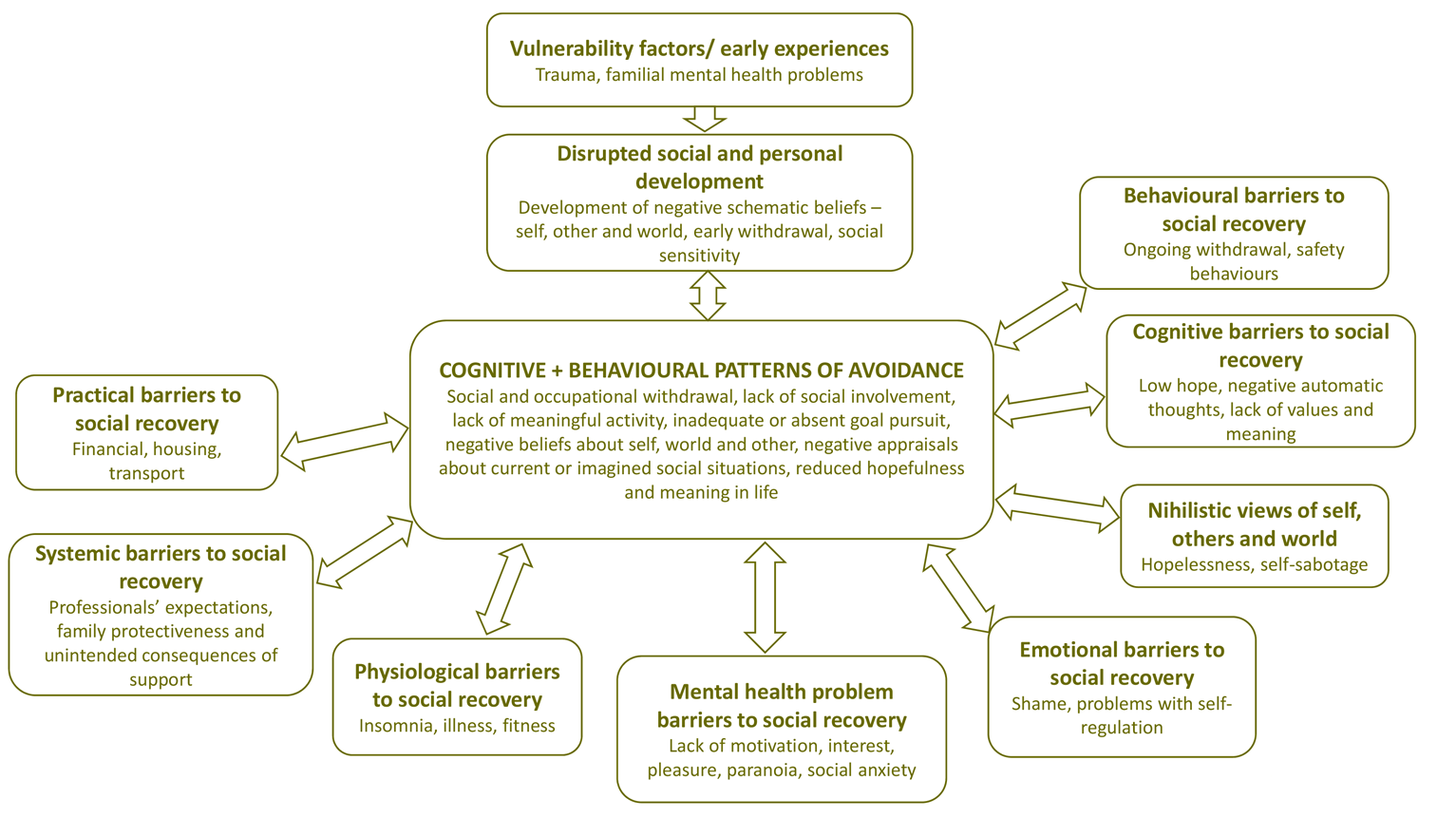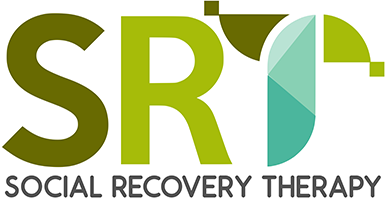SRT Assessment
SRT – Social Recovery Therapy assessment focuses on attempting to understand individuals’ goals and values in relation to social recovery – and barriers to these goals. Assessment information can be gained from the individual, the system surrounding them, and observation in the real-world. Assessment of the wider environment and system can help to identify practical issues that might affect activity, such as access to finances and benefits, problems accessing or using transport, or a lack of awareness of or access to local resources and opportunities. Assessors should consider use of the following:
Methods of goal identification
- SMART goals (specific, measurable, assignable, realistic and time-related)
- Approach goals – ‘approach’ goals may more positively impact on progress compared to ‘avoidance’ goals, i.e. framing goals as things individuals want to achieve/increase/work toward rather than things they want to reduce/stop doing
Assessing values
- Assessing valued life directions, i.e. a sense of what is important to the individual, who they want to be and where they want their life to go
- Assessing values are informed by the Acceptance and Commitment Therapy literature DOWNLOAD and can be guided by one or more structured tool
- Values help to guide the identification of meaningful goals and the selection of structured activity which is more likely to be sustained
Assessing possible future selves
- Possible future selves, e.g. hoped for, expected, feared, are powerful motivators of behaviour
- Assessing possible future selves can help to understand motivations for behaviours and elicit values
- Assessment techniques include Interview & Questionnaire and Drawing Techniques
Assessing interests
- Assessing interests can help to inform selection of goals and identification of historically enjoyed or novel activities which are aligned with goals and values
- Assessing interests can be guided using one or more structured tool LINK
Behavioural assessment techniques
- Using behavioural work, such as behavioural experiments, can inform assessments by helping to identify potential barriers to social recovery in real-time
- This can be particularly helpful for individuals who struggle to reflect on their experiences in formal clinical settings or in typical discussion
SRT Formulation
SRT Assessment & Formulation begins at the start of Social Recovery Therapy but continues throughout the course of the intervention. The key focus of SRT formulation is on understanding the barriers which are complicating or preventing the individual from engaging in structured activity in line with their values and goals.
Longitudinal formulation of social disability: Understanding how the difficulties developed
Social disability is often quite longstanding and may have roots in early adolescence or even childhood. There may have been key events (such as bullying) which triggered the onset of the difficulties. Memories or images from these events may be triggered by certain situations which the individual is thus avoiding. Moreover, social withdrawal at an early age may have reduced the extent to which an individual was able to develop and practice the social skills needed to engage with their peers. Initially, individuals may prefer to discuss current maintenance cycles rather than past experiences and thus it may be best to return to historical issues later in therapy.

Social disability maintenance cycles: Understanding how the difficulties are maintained
It is likely that there will be several maintenance cycles which need to be considered in order to understand an individual’s current difficulties. Common themes include:
Cognitive and behavioural patterns of avoidance
- Avoidance can derive from self-regulation of unusual experiences, difficult emotions, or ‘information-overload’.
- Avoidance can serve many functions for someone with complex difficulties, such as…
A safety behaviour in order to manage situations which may create anxiety
A protective strategy to manage fears of failure. - Avoidance limits opportunities for testing out fears and negative self-beliefs and reduces associated anxiety, thus maintaining the difficulties in the long-term.
- Understanding the nature of the avoided situation/s is of central importance.
- Specific cognitive and behavioural patterns of avoidance include…
Additional safety behaviours such as averting eye contact or rehearsing conversation maintain difficult emotions and negative self-beliefs by preventing individuals finding out they can cope with feared situations.
Lack of structured activity can maintain low mood by preventing individuals from experiencing achievement, mastery, closeness or pleasure.
Lack of hope and positive beliefs about self, world and future may lead to behavioural patterns of withdrawal and amotivation.
A range of symptoms (including emotional symptoms such as anxiety or low mood, or physical symptoms) may maintain low activity levels. Individuals may then get stuck in a cycle of ‘waiting until they feel better’ before engaging in activity.
Multi-systemic factors
The social network – friends, family, partners, carers – with the best intentions, may try to protect an individual from further difficulties and thus prevent them from engaging in new experiences. This may maintain a sense of vulnerability and fears of failure.
Colleges/schools/employers may promote avoidance through trying to reduce an individual’s distress levels (e.g. by allowing an individual to leave a classroom). Mental health stigma may also act as a barrier to engagement in school or work.
Wider society can create structural and financial barriers to structured activity. For example, difficulties impacting on school attendance may lead to a lack of qualifications which complicate engagement with further education or work.
As formulations develop, behavioural assessments and experiments can be used to test out some of the underlying beliefs and behaviours identified in the assessment and formulation phase. It is not necessary (and may not be possible) to have a full longitudinal formulation before behavioural or cognitive work can begin. Indeed, findings from behavioural work can then be incorporated to refine the formulation. Initial progress may be followed by a re-emergence of fears or symptoms and individuals may revert to using avoidance to cope with this. Returning to the formulation to understand this process is key to maintaining progress.
Additional resources
SRT Assessment and Formulation Training Package: DOWNLOAD
SRT Interest Checklist: DOWNLOAD
SRT Values Map: DOWNLOAD

